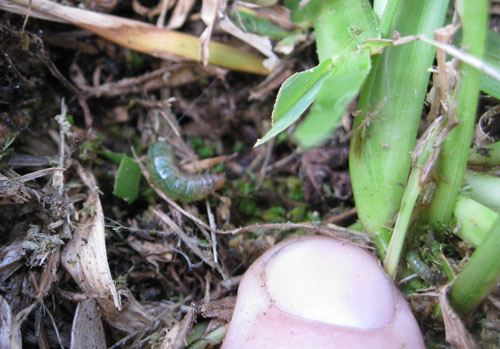
by Taylor Vandiver | Sep 9, 2014
What’s eating my lawn? Does your grass look ragged in areas, as if someone randomly used a weed-eater here and there? Are you noticing brown patches that have a closely clipped appearance compared to other areas of your lawn? Your turf may be playing host to Tropical Sod Webworm.
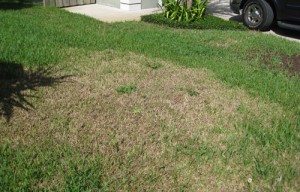
Sod webworm damage in a home lawn. Photo courtesy UF/IFAS.
Sod webworm damage is subtle at first. You have to look closely to notice larval feeding damage. However, an easy indication of their presence is the light tan/brown colored moths, which are the adult stage of the pest. You may see them fly up as you walk through your lawn or if you disturb a nearby bush. The moths do not cause any damage to the turf, but they are depositing eggs, which will result in their offspring, the caterpillars, who do all the chewing damage.
The larvae are gray-green and have spots on each segment. The mature larvae can be up to 1 inch in length. Larvae will curl up in the soil during the day and feed at night. So if you happen to notice caterpillars feeding during the day, it’s probably not sod webworm. You will notice chewed notches along the leaf blade, holes in the leaf and even leaf blade skeletonizing. The older the larvae are, the more they will eat. Damage may start out as a ragged appearance in your turf, which can be hard to diagnose. However, if left unchecked, sod webworm can cause considerable injury to your lawn.
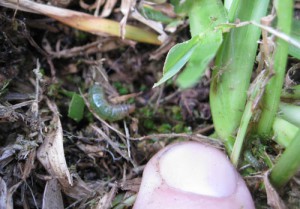
Sod webworm larvae. Photo courtesy UF/IFAS.
If you are uncertain of their presence you can always use a soap drench to flush out larvae. Mix 2 tablespoons of dish soap with 2 gallons of water and pour it over a damaged area (about 3 square ft.). The soap mixture will irritate the pest and bring them to the surface so you can easily identify them. If nothing appears in the area tested move to another damaged site and try again. Here is a link to a video that will give more information on identifying Tropical Sod Webworm.
Tropical Sod Webworm is considered a pest of all warm-season turfgrasses. However, St. Augustinegrass is most commonly affected. The best way to prevent a pest infestation is to use proper cultural maintenance practices for your lawn type. However, if the pest does appear, chemical control should be targeting the larvae stage of the pest. There are multiple products marketed to control lawn caterpillars. However, you may want to consider using B.t. (Bacillus thurengiensis), which is a bacterium that will only harm caterpillars and not bother beneficial insects that may be in your lawn. For more information you can contact your local extension office.
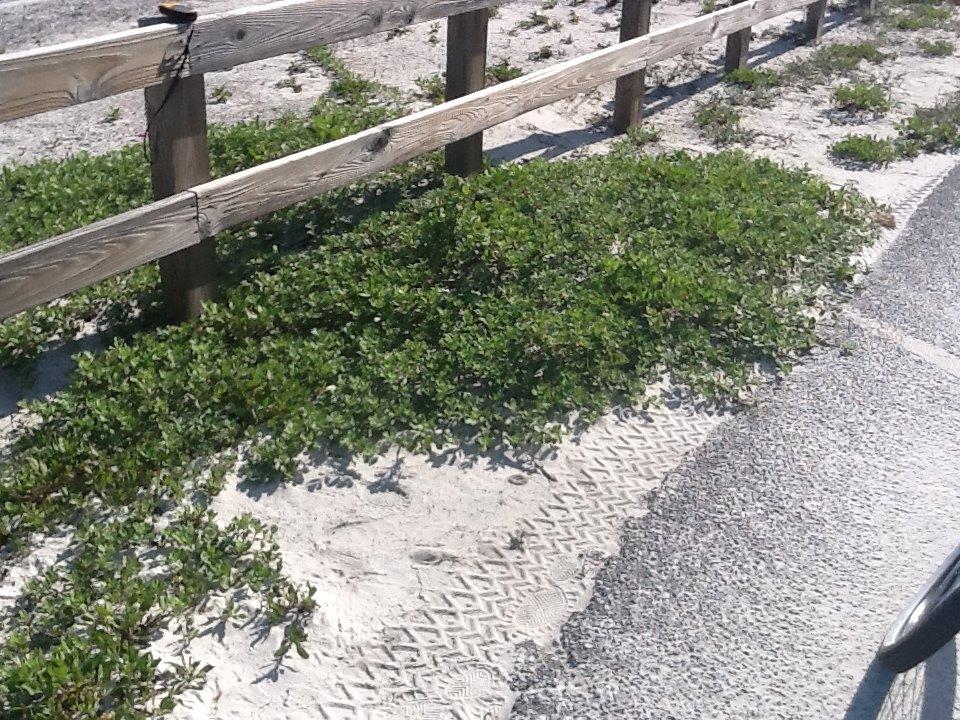
by Carrie Stevenson | Jul 21, 2014
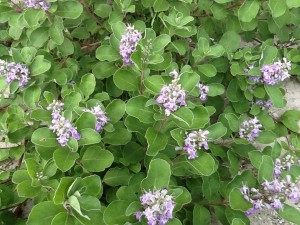
Many beachfront dwellers have intentionally planted beach vitex because of its attractive purple flowers. Photo credit: Rick O’Connor
Now that summer is in full swing, many of us are spending more time on our gorgeous Gulf beaches. Sea turtles are nesting and everyone gets excited at sightings of dolphins, sharks, and the Blue Angels. However, we have another recent visitor to our beaches, and this one isn’t spending money and renting condos. It has moved in from out-of-state and plans to stay, potentially wreaking havoc to our fragile beach dune ecosystems.
Florida is no stranger to invasive species. Reports and stories of pythons, popcorn trees, feral pigs, and others can be found everywhere. As a matter of fact, Florida and Hawaii have more problems with exotic plants and animals than any of the other states.
Beach Vitex (Vitex rotundifolia) is originally from the coastal areas of the western Pacific. It was brought to the United States by North Carolina State University in the 1980’s to restore dunes along coastal Carolina after severe storms. The plant is very salt and drought tolerant and performs well in direct sun and sandy soils; perfect for our coastal beaches. It grows about 3 feet tall and produces branches that extend along the surface of the sand over 60 feet from the tap-root. The flowers are lavender and found in the spring. By midsummer the flowers have dropped and pea-size dark fruit is produced. The fruit is also salt tolerant and can be carried by ocean currents as well as birds. The plant seemed a perfect choice for restoration projects.
And then…
And then it began to overgrow the primary dune system, choking the majority of the native plants including sea oats. The shrub size of the plant and the presence of vertical tap roots in lieu of fibrous ones did not suit it well as a dune forming plant; some studies found that it actually increased the erosion of some dune fields. Beach vitex releases allelopathic compounds, reducing the water content of the soil which stresses native plants thus reducing competition for space. And then there are the sea turtles. Evidence indicates that the growth of this plant over the primary dunes has made it difficult for female turtles to find nesting areas, while fast growing branches grow over incubating nests and make it difficult, if not impossible, for the hatchlings to emerge. The plant has become such a problem that it has been dubbed “Beach Kudzu” and there is a two-state task force to remove it.
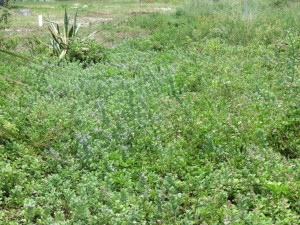
Beach vitex grows quickly and can rapidly take over an entire yard or beach dune. Photo credit: Rick O’Connor
Beach vitex has dispersed north to Virginia and south into Georgia. Currently it has been reported in only three Florida counties; Duval, Santa Rosa, and Escambia. Because of the few records in our state it is not currently listed as an invasive plant in Florida. The problem is, most biologists will tell you that the best way to eradicate an invasive species is to get it early. However most do not see the introduction of a new plant or animal as invasive until it becomes established and difficult to remove.
Natural Resource Agents with UF IFAS Extension are tracking the locations along the coast of the panhandle where this plant may exist. If you believe you may have it please let us know so that the location can be recorded. If you are interested in removing the plant we recommend cutting back to the tap-root. Dab the remaining tap-root with Round-Up. It is best if the remaining parts of the plant do not leave the property; if legal it is ok to burn. If you must transport it off the property we recommend it be dried on concrete and then double bagged before removing to the landfill. In many cases it may take several years to completely remove this plant. If you have any questions about this plant please call your local county Extension Office. Special thanks to Sea Grant Agent Rick O’Connor roc1@ufl.edu for use of this article.
by Taylor Vandiver | Jul 1, 2014
The summertime often reminds us of our uninhibited spirit. With Independence Day not far off, Floridians will be celebrating the freedom of our nation while battling the oppressive climate you can’t seem to escape this time of year. As we approach the apex of heat and humidity here in Florida, we would do well to remember the tenacity of our native wildflowers and their “spirited” survival of Florida’s extreme conditions.

Coreopsis flowers. Photo courtesy UF/IFAS.
Historically, Florida’s landscape was alive with color throughout the seasons. Through urbanization and cultivation we’ve lost a large part of that legacy; however, we can reestablish some of Florida’s colorful past in our own yards and neighborhoods.
In order to ensure successful planting of wildflowers it is important to properly select and prepare your site. You will want to choose a sunny-well drained area and cut any existing vegetation to the ground. It may be beneficial to put down sheets of cardboard to smother what’s left of the vegetation. This is best done in the summer in advance of fall planting.
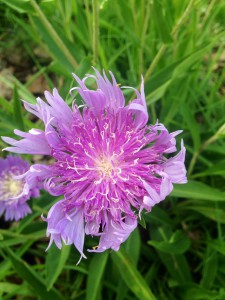
Stokes’ Aster in bloom.
Planting is best done late August to early September in North Florida. Soil-to-seed contact is critical so 1 day before seeding, or just prior to seeding, firmer soils need to be lightly scratched with a rake. Sandy soils might have to be made more firm to ensure that seed do not sink too deep. Broadcast the wildflower seeds at the recommended rate then press them into the soil by walking around on the planting site.
Wildflower seeds require adequate moisture during germination. After planting irrigate the site with about 1/4 to 1/2 inch of water daily for the first few weeks. After that, irrigate with about 1/2 inch water only if the wildflowers show signs of drought stress. Once established though, the meadow needs very little, if any, irrigation. Fertilizers should be avoided altogether as they promote the growth of aggressive weeds. Many of Florida’s native wildflower species are adapted to and perform well in soils with low fertility. Your wildflowers will re-send themselves if given the opportunity so wait until seed have matured before deadheading or mowing. Cut no lower than six to eight inches to avoid damaging the crowns of grasses and wildflowers.
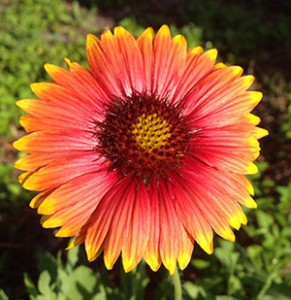
Native Gaillardia. Photo courtesy UF/IFAS.
To successfully cultivate a wildflower meadow in your home landscape, it’s helpful to select plants with the qualities to fit the conditions at your site. Also, consider blooming dates of flowers in order to provide color and interest for your landscape spring through fall. While not always possible, it’s best to purchase seeds and plants known to be Florida ecotypes. Consult with local nurseries and garden centers for more information on plant and seed availability and seeding rates. You can always contact your local Extension Office for more information. Other good sources of information are the Wildflower Seed And Plant Growers Association, Inc. (www.floridawildflowers.com); Association of Florida Native Nurseries (www.afnn.org); and the Florida Wildflower Foundation (www.floridawildflowerfoundation.org).
Growing wildflowers can restore a special sense of natural history close to home. So if you are looking for an “explosion” of color that will stand the test of time, Florida’s native wildflowers will not disappoint.









